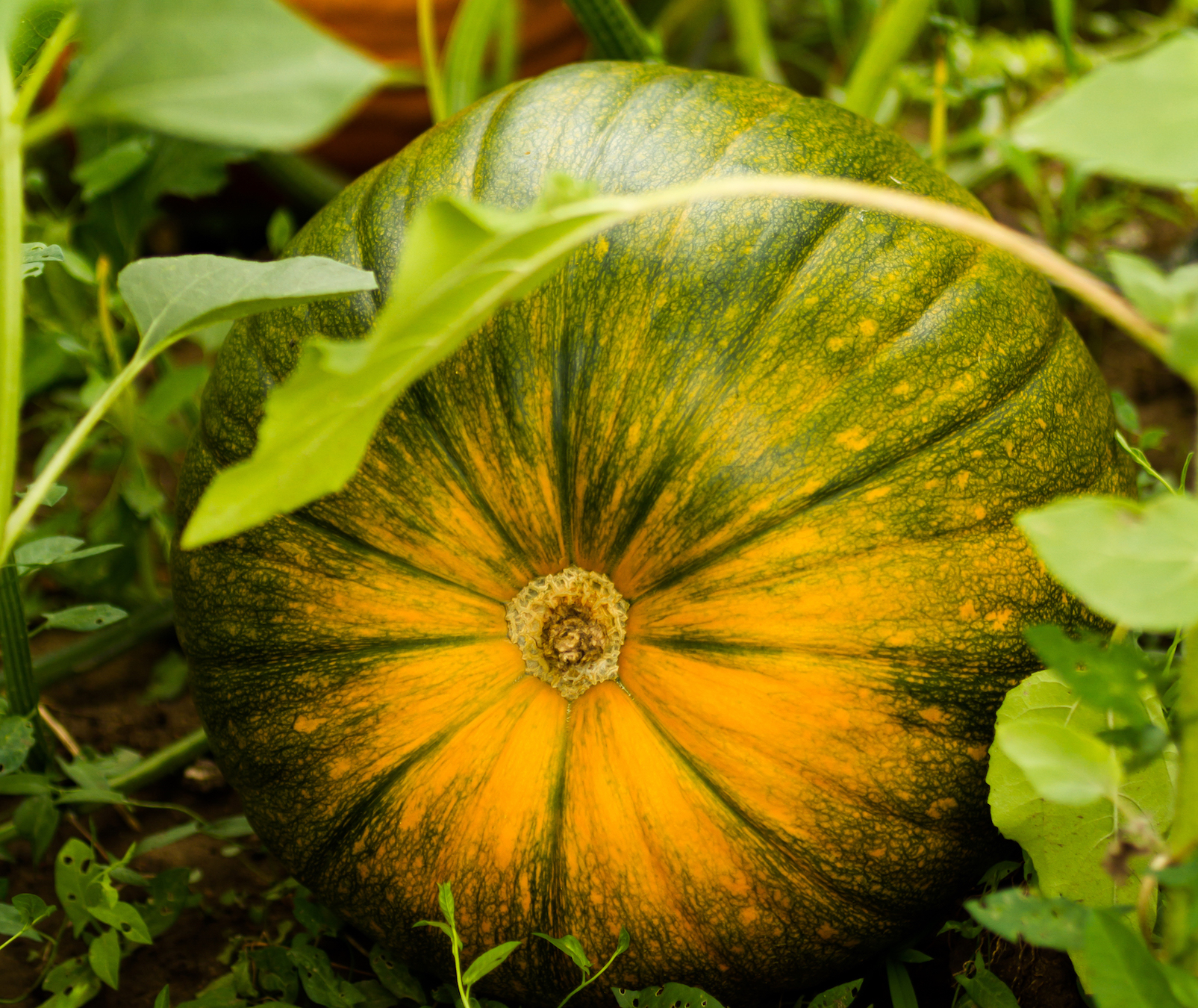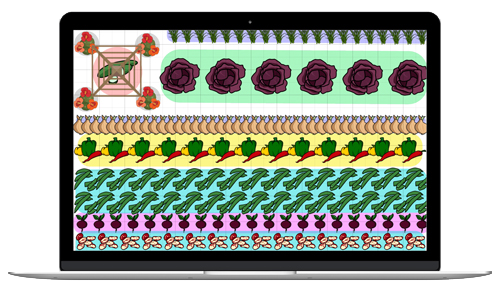
From spooky jack-o'-lanterns to homemade pies, learn how to plant, grow, and store pumpkins
The Almanac Garden Planner - Use It Free for 7 Days!
Plan your 2025 garden with our award-winning Garden Planner.
Types
Every pumpkin has a best purpose. When choosing a pumpkin, think about what you want to do with it. All pumpkins are technically edible, but ornamentals are better for carving, and other pumpkins are best for cooking.
Miniature Pumpkins
Miniature pumpkins are very productive and easy to grow, sometimes producing up to a dozen fruits per plant.
- ‘Jack Be Little’, a miniature variety, is dual purpose. Store-bought shiny (painted) ones make an ideal decoration for a holiday table. Remove the seeds from farm- or homegrown specimens and then bake them for a tiny treat. Vine variety. Days to maturity: 90 to 100.
- ‘We-B-Little’ is an All-America Selection winner, and ‘Munchkin’ is another great miniature pumpkin.
Pumpkins for Carving
- ‘Autumn Gold’ is great for carving and decorating. All-America Selection winner. Vine variety. Excellent for jack-o’-lanterns. Days to maturity are generally 100 to 120.
- The larger ‘Magic Lantern’ and ‘Merlin’ are great for carving and decorating.
Giant Pumpkins
- ‘Dill’s Atlantic Giant’ jumbo variety can grow to 200 pounds. Great for those who want to grow a ginormous pumpkin. Vines will spread to 25 feet, so space is a must. Days to maturity are 130 to 160, so plant early! Thin to the best one or two plants. Feed heavily but keep cultivation shallow. Remove the first two or three female flowers after the plants start to bloom so that the plants grow larger with more leaf surface before setting fruit. Allow a single fruit to develop and pick off all female flowers that develop after this fruit has set on the plant. Take care that the vine doesn’t root down near the joints to avoid breakage.
- ‘Big Max’, ‘Big Moon’, ‘Jack O’ Lantern’, and ‘Funny Face’ are some of the best giant pumpkins for carving.
Perfect Pumpkins for Pies
- ‘Sugar Treat’ is excellent for cooking and baking. Days to maturity are generally 100 to 120. ‘Hijinks’ and ‘Baby Bear’ are both All-America Selection winners and have sweet flesh for pumpkin pie.
- ‘Cinderella’s Carriage’ is also perfect for pies or soups.
- ‘Peanut Pumpkin’ also produces very sweet flesh and can be great in pumpkin pie or pumpkin puree.

Colorful Decorative Pumpkins
- ‘Jarrahdale’ has blue-green skin and makes for great decorations.
- ‘Pepitas Pumpkin’ is orange and green.
- ‘Super Moon’ is a large white pumpkin.
Cooking Notes
- See how to clean a pumpkin for cooking.
- Don’t forget about the seeds! Roast them with salt or cinnamon for a tasty treat.
ADVERTISEMENT
Glad too hear things are going so well for you, Shawna. Here’s where you can get your first/last frost dates: https://www.almanac.com/gardening/frostdates
If indeed your LAST frost date—the one that ends the winter—is Jan 12 or 21, then you have a long growing season. If when the time comes you think that indeed there would not be any frosts after that date it would seem like you could plant. BUT, you have to remember that the dates are not absolutes; they are estimates based on historical weather patterns…and we all know that those can shift. To be on the safe side, since it appears that you do have a long season, you could start seeds indoors or simply wait a while, based to a certain extent on the growth period to maturity that the pumpkin needs (which appears to be about 100 days). Would an early start produce a larger squash? Hard to tell. One source suggests that the seeds produce pumpkins of 6 to 10 pounds. But it could depend on numerous factors, from weather to soil to water and more. And, no small matter, rotating your crops. Try to avoid growing your pumps in the same spot you grew them in this year. Hope this helps!
Thanks for your Pumpkin Growing info; I have seen Halloween Pumpkins which leave the dried curly tendril on a longer stem; I see them on mini pumpkins; I like the Orange Pumpkin w dry stems too; (don't pick a pumpkin up by the stem; the stem won't hold the pumpkin);
Thanks for your comments!
When you say pumpkins should be fed regularly, what does that mean? Every day? Every week? Every month? Beginners need more direction...
Also, you recommend compost, old manure, (how old?) nitrogen and phosphorus as fertilizers. Just compost and manure or just a commercial fertilizer with nitrogen and phosphorus, or all those components together? Beginners need to know. Thanks.
Hello, MJ, “Regular” usually means once per week (e.g., regular watering usually means once per week), but it can depend to a certain extent on what ferilizer product you use, Consult the packaging for guidance first. Old or aged manure standardly means at least a year old. Anything younger/newer could be too “hot” and burn the plant/s. See here for more in manure: https://www.almanac.com/what-best-manure-compost-gardens and search this site for “manure,” too. Compost and aged manure combined is best; one or the other may be adequate depending on your overall situation (soil quality, etc., the best measure of which is a soil test; see https://www.almanac.com/how-take-soil-test and search “soil test” on this web site for more info). For more in nitrogen and phosphorus, see this page, which explains their presence in commercial fertilzers: https://www.almanac.com/content/npk-ratio-what-do-numbers-fertilizer-mean
We hope this helps.
I planted several varieties of pumpkins. One of them was rouge vif d’etampes. Another was the Atlantic giant and the crinkle family. My rouge pumpkins are getting huge. Is that because I planted them with the other pumpkins? They are huge and still yellow. With green spots. Did I do something wrong?
Thank you,
Diane
I have a kind of weird question! Is it possible to grow pumpkins, anywhere in the US, out of season? Perhaps fully in a greenhouse? I am working on a project that would need Halloween style carving pumpkins in May and June. I have searched all over the internet and have found little to no information. I have been laughed at by pumpkin farms I've called. If anyone has any ideas or info on if this is even possible, I would LOVE to hear it! Thank you!
It depends where you live. In warm-winter regions,you can sow pumpkin seeds in midwinter for harvest in early summer.
Hi I'm growing a pumpkin plant completely indoors from seed to harvest.
It's hydroponic/Soilless my question the i haven't been able to find the answer to online is, do pumpkins require the light cycle to change BEFORE they will produce flowers.
I'm currently growing it under grow lights at 18 hours of "daylight" and 6 hours of darkness. The vine is growing at an incredible rate but do I have to change to "autumn/late summer" light cycle before I can get flowers?
Good question! I don’t believe squash (including pumpkins) rely on changes in photoperiod (day length) to trigger flowering. If started from seed in the spring, squash will flower before the June solstice, while daylight hours are still increasing. Flowering is affected more by temperature and light intensity. Perhaps one of those factors is causing your plant not to flower yet. Or, it could simply be that it’s not old enough or requires a different nutrient mix (less nitrogen). Here’s some more info about growing squash and pumpkins via Purdue University: Cucurbit Growth and Development











